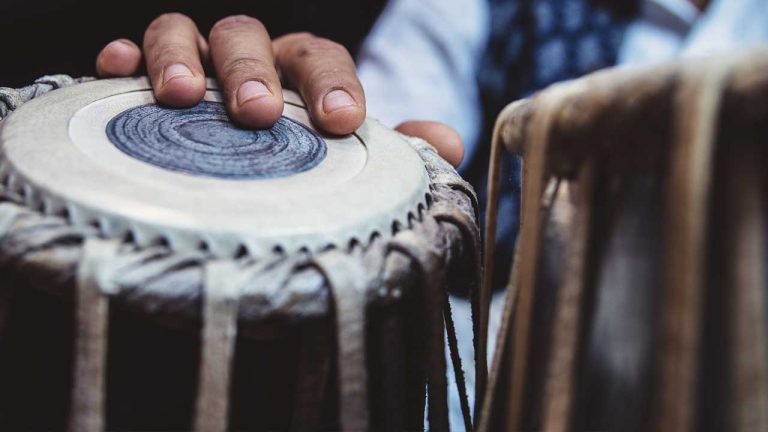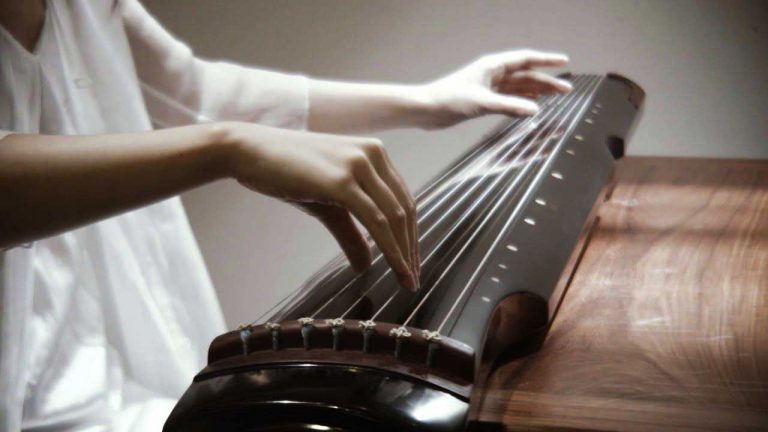What Is The Sarod Instrument? The Lesser-Known Indian Gem
Folkstrings.com is reader-supported. When you buy through links on our site, we may earn a small commission.
What Is a Sarod?
You know those typical Hindu movie or television musical scores? One of the unique sounds that produced them is the sarod.
A sarod is a stringed instrument with 25 strings, 15 of which are sympathetic–meaning they resonate the vibrations of their nearby strings. It has a broad neck and its metal fingerboards are distinct with no frets, allowing the player’s fingers to slide on the fingerboards for pitch differences. The bottom part of the sarod is shaped like a gourd making it similar to a sitar.
When it comes to the question ‘what is the sarod instrument?’ One may see the sarod and immediately liken it to the common lute; that’s because it is indeed part of the lute family.
The instrument is played using a plectrum at the right hand used to pluck the strings while the left hand presses on the strings.Wood covered with skin is usually the built of the sarod’s body and a metal gourd in the instrument serves as the resonator for sympathetic harmony.
Common to Northern India, Pakistan, and Bangladesh, the sarod instrument is adapted from the Afghan rahab which made its appearance in India during the 16th century. Nowadays, a more modern 19th century style sarod measures 100 cm and is more commonly used by players around South Asia.
Is Sarod Difficult to Play?

Playing an instrument with 25 strings seems intimidating for real. If one is eager and has experienced playing any string instrument, the sarod is a doable feat. But fret not (pun intended).
According to sarod players, what makes it more difficult to maneuver than the sitar is the lack of frets. Players need to manually press on the fingerboard to get to a specific pitch. Newbies need to learn proper plucking using the plectrum and placement of the left hand on the strings along with guidance from a professional sarod player.
It boils down to coaching, most players say. A good coach first teaches correct plectrum grip, finger placement, and pluck intensity. People with no experience playing stringed instruments but are interested in playing the sarod whether as a hobby or a cultural appreciation practice can definitely sit with a coach to help them learn correctly.
With consistent coaching and dedication, one should get the hang of the basics in around six months.
Is Sarod and Sitar the Same?
Aside from the question of ‘what is the sarod instrument?’ comes the question of whether the sarod and sitar are the same or in some way similar.
The noticeable difference between the sitar and sarod would be the latter’s lack of frets.
There are notably more people who prefer being a sitarist than a sarodist. Mainly because the presence of frets on a sitar makes it easier to memorize pitches rather than DIY-ing pitches on a sarod.
A sitar produces a twangy, happy tune when plucked and contrasts a sarod’s deep and brooding tone. For people who like the challenge of playing the sarod, what makes it stand out is the instrument’s ability to take a note up to an octave while a sitar can only carry up to five notes.
Still, a sarod stands out with its rich and rhythmic patterns.
Author Profile
-
Daniel Johnstone is an English writer with a love for stringed instruments from around the world.
He shares his love for these instruments through his writing for folkstrings.com, a website dedicated to all things related to folk string music.
Daniel's passion for music started at a young age, and he has since become an accomplished musician, playing guitar, cavaco, and recently, the harp.
His dedication to learning and sharing his knowledge of stringed instruments is evident in his insightful and engaging blog posts. Whether you're a seasoned musician or a beginner, Daniel's writing is sure to inspire and entertain you.
When he's not playing music or writing, you can find Daniel exploring new instruments and seeking out new sounds to share with his readers.
Latest entries
 AutoharpApril 4, 2024What Is the Autoharp Made Of: Exploring Its Materials and Craftsmanship
AutoharpApril 4, 2024What Is the Autoharp Made Of: Exploring Its Materials and Craftsmanship AutoharpApril 4, 2024Is Autoharp Easy to Play? Unveiling the Truth for Beginners
AutoharpApril 4, 2024Is Autoharp Easy to Play? Unveiling the Truth for Beginners AutoharpApril 4, 2024What Is an Autoharp Worth? Your Guide to Pricing and Value
AutoharpApril 4, 2024What Is an Autoharp Worth? Your Guide to Pricing and Value AutoharpApril 4, 2024Are Autoharp and Zither the Same Thing? Unraveling String Instrument Myths
AutoharpApril 4, 2024Are Autoharp and Zither the Same Thing? Unraveling String Instrument Myths
Affiliates:
This post may contain affiliate links that at no additional cost to you, the site may earn a small commission. We only recommend products we would use ourselves and all opinions expressed on this site are our own.
Accuracy Advice:
While we strive to provide up-to-date and accurate information, the content in this article may not reflect the most current research or medical guidelines. We encourage readers to do further research and consult with professionals for more personalized advice.
Our Recommendations:
The products and services mentioned in any of our articles are recommended based on our independent research and personal experience. We are not sponsored by any company. We aim to suggest products and services we believe are of high quality and could be beneficial to our readers.







